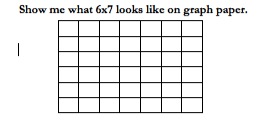- MN ABE Connect
- Archive
- Making Equations Visual to Enhance Understanding
Making Equations Visual to Enhance Understanding
Abby Roza, Instructor What if we could draw a picture of the meaning of a quadratic equation or build it using manipulatives? What if students saw writing algebraic equations as a useful tool or as a fun and challenging puzzle?
What if we could draw a picture of the meaning of a quadratic equation or build it using manipulatives? What if students saw writing algebraic equations as a useful tool or as a fun and challenging puzzle?
At the COABE (Commission on Adult Basic Education) national conference this year, Lynda Ginsburg and Patricia Helmuth presented on using visual models and engaging activities to teach about quadratics. As this is an area of math that is on the complex end for many of our GED students and one that, as teachers, many of us only have an abstract understanding of, I was eager to see what they would offer.
 Beginning with student-made with arrays for single and double digit multiplication, the presenters built up to similar arrays and grids that could be used for multiplying polynomials and then for factoring quadratics. In addition to supporting a student’s ability to solve quadratic equations, this process frames students’ and teachers’ understanding of quadratic equations and multiplying polynomials as the next step in what they already understand about multiplication and numbers. Teachers who teach basic operations (add, subtract, multiply and divide) may find learning about this progression enriches how they teach those concepts.
Beginning with student-made with arrays for single and double digit multiplication, the presenters built up to similar arrays and grids that could be used for multiplying polynomials and then for factoring quadratics. In addition to supporting a student’s ability to solve quadratic equations, this process frames students’ and teachers’ understanding of quadratic equations and multiplying polynomials as the next step in what they already understand about multiplication and numbers. Teachers who teach basic operations (add, subtract, multiply and divide) may find learning about this progression enriches how they teach those concepts.
In a second activity, participants were presented with a visual pattern. We were asked to predict upcoming figures, describe what was happening in words, and ultimately to write an equation for the pattern.

Source: visualpatterns.org
I have begun to try variations on this activity with my students and I can report success! We have used them with linear equations so far. Students who otherwise might be intimidated to start an algebraic problem-solving activity jumped right in. Students with basic math skills worked in the same room, on the same activity, with students with more formal math training, and both were engaged and appeared to have “ah-ha” moments. Students were interested in each other’s strategies. The activities, and the discussions of the growth of the pattern, have given us another touch point for understanding equations. I predict that my students who have access to these activities will have a greater understanding (and for some, possibly more interest) than what we have developed in the past with only formulas and graphs.
Implementing the activity highlighted some areas for my own growth as an instructor as well. Reflecting on the lesson, it is clear that my students would benefit from some additional language supports – such as writing and speaking frames, and perhaps differently structured times for brief sharing of ideas. Students benefited from varied access to manipulatives, which has made me rethink the ways I make them available to students. Some of the students graphed the equation they came up with, and I would like to develop a structure that would help students notice and wonder about the connections between the graph, the equation and the pattern. I also want to increase students’ ability and opportunity to articulate their thinking and reflect on each other’s thinking.
If you try these (or already use) algebra activities with visual patters, I would love to hear from you! Email Abby at [email protected]
Using Visual Models – Step by Step
Would you like more detailed information on how to use visual models for math in your classroom?
Related Resources:
- Visual Patterns website
- Visual Patterns student worksheet
- The teacher behind the visual patterns website, Fawn Ngyuen, describes how she uses number talks and pattern talks
- Additional resource: CollectEdNY
Newsletter Signup
Get MN ABE Connect—the official source for ABE events, activities, and resources!
Sign UpArticle Categories
- ABE Foundations/Staff Onboarding
- ACES/Transitions
- Adult Career Pathways
- Assessment
- CCR Standards
- Citizenship
- COVID-19
- Cultural Competency
- Digital Literacy/Northstar
- Disabilities
- Distance Learning/Education
- ELA
- Equity/Inclusion
- ESL
- HSE/Adult Diploma
- Listening
- Math/Numeracy
- Mental Health
- Minnesota ABE
- One-Room Schoolhouse/Multilevel
- Professional Development
- Program Management
- Reading
- Remote Instruction
- Science
- Social Studies
- Speaking/Conversation
- Support Services
- Teaching Strategies
- Technology
- Uncategorized
- Volunteers/Tutors
- Writing